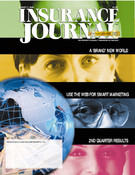“[Branding] starts with a vision on the top and has to be extended across all points of touch… it isn’t something that’s just window dressing.”
The concept of branding is about much more than names, logos and advertising campaigns. In the most basic sense, a brand is really about making a promise and being able to deliver that promise. By successfully branding its products or services, an independent agent can create growth while at the same time, separate itself from the competition.
“The insurance industry in general is prime for branding,” said Alan Bergstrom, president and CEO of The Brand Consultancy, a leading international brand strategy consulting firm specializing in the characterization, positioning and leverage of brands. “We’ve done some work for some of the large providers…and from a national level or even an international level, there’s interest in creating some tighter loyalty and affinity around those brands.
“But I think the opportunity also exists at the local level-in the actual retail environment—for the agents and the agencies to create their own identity.”
Big or small, companies need to brand themselves. “It’s hard for small companies in some ways, but in other ways it’s not,” said Hayes Roth, senior executive director of Landor Associates, one of the nation’s leading experts on building and managing brands. “If you are a small company [or agency], your audience in most cases is fairly small as well, so it isn’t like you have to go out and spend millions of dollars to tell your 500 customers what you’re about.
“But you do have to have an idea and you have to have a commitment to it and you have to be fairly dedicated to expressing that brand in a consistent way whenever you use it. It could be termed internal branding or living the brand—but again, it’s more than pretty pictures and a clever name.”
Roth called it common sense. “In essence, a brand is that capsulation of everything that an organization or a product ultimately stands for in the mind of its customer.”
Digging deep with a brand strategy
Over the past 18 months, the Independent Insurance Agents of America Inc. (IIAA) has been busy conducting extensive research and analysis of its members’ position in the marketplace as part of a branding initiative. The primary goal is the development of a branding strategy that will communicate to consumers nationwide the value of its independent agent members.
“In the beginning, we knew we needed some outside help, and it was really important to us that we not choose an agency or a firm that was predisposed to promoting the value of agents in a certain way,” said Maureen Wall, IIAA vice president of communications.
The Big “I” chose Addison, a San Francisco-based branding and communications firm, to conduct the branding study; to examine a variety of issues that could affect independent agents’ market share, including purchase and service preferences, understanding of the independent agency channel and logo recognition.
Specifically, the study revealed that the Big “I” logo is not resonating with consumers in the way that the association had hoped.
As a result, the Big “I” is looking to develop a separate marketing brand that would better convey to consumers the value that independent agents bring to the insurance transaction.
“It isn’t simply a matter of [needing] to promote the Big ‘I’ logo a little bit more; we found that the logo actually had some baggage to it-that it wasn’t clear to consumers what an independent agent was,” Wall said. The separate marketing brand will be unveiled at the association’s 105th Annual Convention & InfoXchange, to be held in Orlando in October.
The Big “I” logo will continue to be used within the industry, but will most likely be “a little bit more cleaned up—a little bit more modernized,” according to Wall.
The fact is, in order to be successful at branding, it’s not enough just to advertise. “You really need to look at what you deliver to customers, what customers want from you, and make sure that you’re delivering on those promises,” Wall said.
The issues being discussed by the Big “I” are very big issues for agents and will demand a certain amount of effort and change on the part of its members, according to Wall. “But more than any other time…I feel like agents are ready to do this,” she said. “They’re ready for it, they know it’s a competitive marketplace, they know they need to do something, and they’re ready to take the necessary steps.”
What is a brand?
“A brand is really a shorthand way of storing and assembling a whole host of associations and attributes—things that a company or its products and services ultimately stand for-so that you don’t have to think very hard about it,” Bergstrom said.
For any brand-whether large or small-the principles are more or less the same. “You need to figure out what this brand wants to stand for,” he said. “Is it personalized service? Is it the latest application of technology? There is a whole host of angles that an insurance agency could take and stand for, and I think it’s important in determining what the brand is to stand for by: 1) trying to understand who you’re targeting, and 2) what the needs and desires are for that particular target group.”
Brands, Bergstrom said, represent functional and emotional associations-or attributes. Functional attributes are those things that are tangible, such as performance, quality, price, etc., while emotional attributes are those less tangible things such as how the brand makes you feel.
“So it’s really aligning the customer that you are trying to target with his or her needs and building your brand associations and attributes—or positioning, if you will-around those things that have the greatest degree of affinity to the group you’re targeting,” Bergstrom said.
Branding a commodity
For too long, banks and other financial services firms believed that they were commodities and that commodities couldn’t be branded, according to Bergstrom. “To be most effective in the marketplace, you can’t be everything to everybody; otherwise you do, in fact, become a commodity,” he said. “That fact is, the bulk of the market is trying to be everything to everybody, so developing a strong brand is also about who you are not.”
In order for independent agencies not to get caught in the commodity game, Bergstrom stressed that the agency must stand for something. “I guess the analogy would be building a local retail store brand that distributes national products and services. If I want to go to an independent agent to have the options to select a variety of products and services, why would I go to Agency X over Agency Y?
“A Macy’s stands for something…versus a Nordstrom. They may distribute and sell the same products inside the store, but we have different feels and attitudes about them and they attract a certain customer segment that feels an affinity to that particular retail brand. [Independent] agencies have to do the same thing…so, you can move yourself out of a commodity situation—and the way to do that is with a brand.”
Cutting out the fluff
Erich Sippel, president of Erich Sippel & Company, a consulting firm that specializes in strategy and marketing in the insurance industry and related financial services industries, feels that today consumers are faced with too much information.
“I think branding is extremely important and getting more important…but the reasons are backwards from what it used to be,” Sippel said. “In other words, it used to be that the marketplace was characterized by small quantities of core expensive information.
“In that kind of environment, a brand can help you because it adds information to the marketplace and tells you without you having to do any further work, that this brand stands for a certain thing.”
Sippel feels that the world has changed so that today, instead of only small amounts of expensive information being available in the marketplace, there is now a flood of high quality, inexpensive information available. “From the Internet, from magazines, from financial cable networks, from rating services and so on,” he said. “So the role of the distributor is fundamentally different from what it used to be.”
Now instead of companies wanting to supplement an information-poor situation, they are trying to cut through the fluff and find a way to provide more customized, meaningful information. “Individuals don’t need more information-they’ve already got an overload,” Sippel said. “What they need is customized information…and therefore, a brand that conveys that kind of value proposition is well-positioned in this fundamentally changed environment.”
Building a brand
Landor’s Roth finds a challenge in the p/c industry when it comes to branding. “Interestingly enough, certainly in the auto industry and it might be in the casualty business as well, that branding has really taken a second seat,” he said. “Looking at some of the brands in the auto industry, a lot of them are kind of tired-looking and they are going to have [to come to terms with that].
“Thanks to the web, you can shop prices very quickly, so in the end, what are you buying? Well, you’ve got to buy a reputation and the confidence that whoever you’re investing in is going to deliver what they promise, and that’s what a brand is all about.”
Was this article valuable?
Here are more articles you may enjoy.


 Coverage Needed: Hundreds of Thousands in SE Now in Flood Zones With New Maps
Coverage Needed: Hundreds of Thousands in SE Now in Flood Zones With New Maps  Big ‘I’ Report: Independent Agency Channel Placed 62% of Premiums in 2023
Big ‘I’ Report: Independent Agency Channel Placed 62% of Premiums in 2023  Ford Recalls 668,000 2014 F-150 Pickup Trucks Over Transmission Issue
Ford Recalls 668,000 2014 F-150 Pickup Trucks Over Transmission Issue  A $29 Billion Weed Market Fights to Diversify Amid Legal Hurdles
A $29 Billion Weed Market Fights to Diversify Amid Legal Hurdles 


